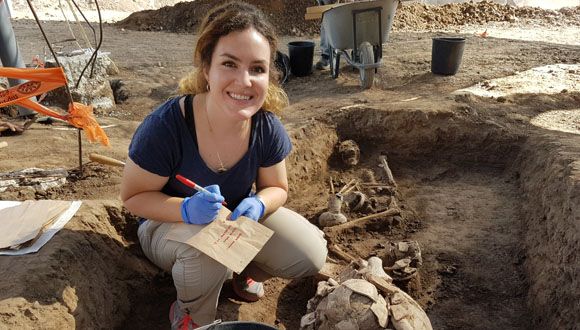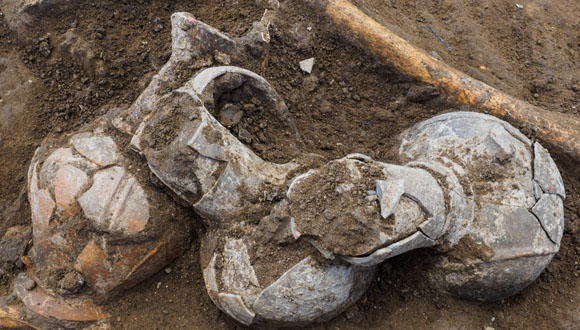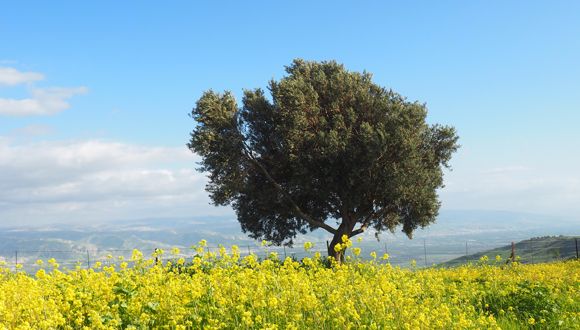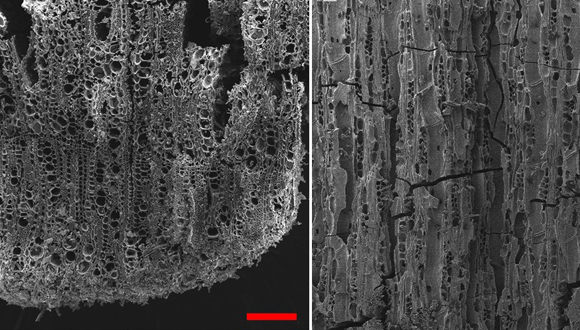Opium residue was found in Israel, dating back to the 14th century BC. Researchers believe Canaanites used the psychoactive drug as offering for the dead


Research
Opium residue was found in Israel, dating back to the 14th century BC. Researchers believe Canaanites used the psychoactive drug as offering for the dead

A new study by the Israel Antiquities Authority, Tel Aviv University and The Weizmann Institute of Science has revealed the earliest known evidence of the use of the hallucinogenic drug opium, and psychoactive drugs in general, in the world. The opium residue was found in ceramic vessels discovered at Tel Yehud in Israel, in an excavation conducted by Eriola Jakoel on behalf of the Antiquities Authority. The vessels that contained the opium date back to the 14th century BC, and were found in Canaanite graves, apparently having been used in local burial rituals.
This exciting discovery confirms historical writings and archeological hypotheses according to which opium and its trade played a central role in the cultures of the Near East.
The research was conducted as part of Vanessa Linares’ doctoral thesis, under the guidance of Prof. Oded Lipschits and Prof. Yuval Gadot of Tel Aviv University’s Department of Archeology and Prof. Ronny Neumann of the Weizmann Institute, in collaboration with Eriola Jakoel and Dr. Ron Be’eri of the Israel Antiquities Authority. The study was published in the journal Archaeometry.
"Because the vessels are similar in shape to the poppy flower when it is closed and upside down, the hypothesis arose already in the 19th century that they were used as ritual vessels for the drug."
In 2012, the Antiquities Authority conducted a salvage excavation at the Tel Yehud site, prior to the construction of residences there. Several Canaanite graves from the Late Bronze Age were found in the excavation, and next to them burial offerings – vessels intended to accompany the dead into the afterlife.
Among the pottery, a large group of vessels made in Cyprus and referred to in the study as “Base-Ring juglets,” stood out. Because the vessels are similar in shape to the poppy flower when it is closed and upside down, the hypothesis arose already in the 19th century that they were used as ritual vessels for the drug.
Now, an organic residue analysis has revealed opium residue in eight vessels, some local and some made in Cyprus. This is the first time that opium has been found in pottery in general, and in Base-Ring vessels in particular. It is also the earliest known evidence of the use of hallucinogens in the world.

Vessels intended to accompany the dead into the afterlife. These Cypriot jugs and juglets were laid on the deceased. Remains of opium were found in several of the vessels (photo: Assaf Peretz, Israel Antiquities Authority)
"It may be that during these ceremonies, conducted by family members or by a priest on their behalf, participants attempted to raise the spirits of their dead relatives in order to express a request, and would enter an ecstatic state by using opium."
"In the excavations conducted at Tel Yehud to date, hundreds of Canaanite graves from the 18th to the 13th centuries BC have been unearthed," shares Dr. Ron Be’eri of the Israel Antiquities Authority. "Most of the bodies buried were those of adults, of both sexes. The pottery vessels which had been placed within the graves were used for ceremonial meals, rites and rituals performed by the living for their deceased family members."
Beeri explains that the dead were honored with foods and drinks that were either placed in the vessels or consumed during a feast that took place over the grave, at which the deceased was, in fact, considered a participant. It may be that during these ceremonies, conducted by family members or by a priest on their behalf, participants attempted to raise the spirits of their dead relatives to express a request, and would enter an ecstatic state by using opium. Alternatively, he says, the opium, which was placed next to the body, may have been intended to help the spirit of the deceased rise from the grave in preparation for the meeting with their relatives in the next life.
"Canaanites attached great importance to ‘satisfying the needs of the dead’ through ritual ceremonies performed for them by the living, and believed that in return, the spirits would ensure the health and safety of their living relatives"
Vanessa Linares of Tel Aviv University explains: “This is the only psychoactive drug that has been found in the Levant in the Late Bronze Age. In 2020, researchers discovered cannabis residue on an altar in Tel Arad, but this dated back the Iron Age, hundreds of years after the opium in Tel Yehud. Because the opium was found at a burial site, it offers us a rare glimpse into the burial customs of the ancient world. Of course, we do not know what the opium’s role was in the ceremony – whether the Canaanites in Yehud believed that the dead would need opium in the afterlife, or whether it was the priests who consumed the drug for the purposes of the ceremony."
"Moreover, the discovery sheds light on the opium trade in general. One must remember that opium is produced from poppies, which grew in Asia Minor – that is, in the territory of current-day Turkey – whereas the pottery in which we identified the opium were made in Cyprus. In other words, the opium was brought to Yehud from Turkey, through Cyprus; this of course indicates the importance that was attributed to the drug.”
Dr. Ron Be’eri of the Antiquities Authority adds, “Until now, no written sources have been discovered that describe the exact use of narcotics in burial ceremonies, so we can only speculate what was done with opium. From documents that were discovered in the Ancient Near East, it appears that the Canaanites attached great importance to ‘satisfying the needs of the dead’ through ritual ceremonies performed for them by the living, and believed that in return, the spirits would ensure the health and safety of their living relatives.”
According to Eli Eskosido, director of the Israel Antiquities Authority, “New scientific capabilities have opened a window for us to fascinating information and have provided us with answers to questions that we never would have dreamed of finding in the past. One can only imagine what other information we will be able to extract from the underground discoveries that will emerge in the future.”

Research
Earliest evidence for cultivation of a fruit tree, according to researchers

A joint study by researchers from Tel Aviv University and the Hebrew University unraveled the earliest evidence for domestication of a fruit tree. The researchers analyzed remnants of charcoal from the Chalcolithic site of Tel Zaf in the Jordan Valley and determined that they came from olive trees. Since the olive did not grow naturally in the Jordan Valley, this means that the inhabitants planted the tree intentionally about 7,000 years ago. Some of the earliest stamps were also found at the site, and as a whole, the researchers say the findings indicate wealth, and early steps toward the formation of a complex multilevel society.
The groundbreaking study was led by Dr. Dafna Langgut of the The Jacob M. Alkow Department of Archaeology & Ancient Near Eastern Cultures, The Sonia & Marco Nadler Institute of Archaeology and the Steinhardt Museum of Natural History at Tel Aviv University. The charcoal remnants were found in the archaeological excavation directed by Prof. Yosef Garfinkel of the Institute of Archaeology at the Hebrew University. The findings were published in the journal Scientific Reports from the publishers of Nature.
According to Dr. Langgut, Head of the Laboratory of Archaeobotany & Ancient Environments which specializes in microscopic identification of plant remains, “trees, even when burned down to charcoal, can be identified by their anatomic structure. Wood was the 'plastic' of the ancient world. It was used for construction, for making tools and furniture, and as a source of energy. That's why identifying tree remnants found at archaeological sites, such as charcoal from hearths, is a key to understanding what kinds of trees grew in the natural environment at the time, and when humans began to cultivate fruit trees."
In her lab, Dr. Langgut identified the charcoal from Tel Zaf as belonging to olive and fig trees. "Olive trees grow in the wild in the land of Israel, but they do not grow in the Jordan Valley," she says. "This means that someone brought them there intentionally – took the knowledge and the plant itself to a place that is outside its natural habitat. In archaeobotany, this is considered indisputable proof of domestication, which means that we have here the earliest evidence of the olive's domestication anywhere in the world.”

7,000 years-old microscopic remains of charred olive wood (Olea) recovered from Tel Tsaf (Photo: Dr. Dafna Langgut)
“I also identified many remnants of young fig branches. The fig tree did grow naturally in the Jordan Valley, but its branches had little value as either firewood or raw materials for tools or furniture, so people had no reason to gather large quantities and bring them to the village. Apparently, these fig branches resulted from pruning, a method still used today to increase the yield of fruit trees."
The tree remnants examined by Dr. Langgut were collected by Prof. Yosef Garfinkel of the Hebrew University, who headed the dig at Tel Zaf. Prof. Garfinkel: "Tel Zaf was a large prehistoric village in the middle Jordan Valley south of Beit She'an, inhabited between 7,200 and 6,700 years ago. Large houses with courtyards were discovered at the site, each with several granaries for storing crops. Storage capacities were up to 20 times greater than any single family's calorie consumption, so clearly these were caches for storing great wealth. The wealth of the village was manifested in the production of elaborate pottery, painted with remarkable skill. In addition, we found articles brought from afar: pottery of the Ubaid culture from Mesopotamia, obsidian from Anatolia, a copper awl from the Caucasus, and more."
Dr. Langgut and Prof. Garfinkel were not surprised to discover that the inhabitants of Tel Zaf were the first in the world to intentionally grow olive and fig groves, since growing fruit trees is evidence of luxury, and this site is known to have been exceptionally wealthy.
Dr. Langgut: "The domestication of fruit trees is a process that takes many years, and therefore befits a society of plenty, rather than one that struggles to survive. Trees give fruit only 3-4 years after being planted. Since groves of fruit trees require a substantial initial investment, and then live on for a long time, they have great economic and social significance in terms of owning land and bequeathing it to future generations – procedures suggesting the beginnings of a complex society. Moreover, it's quite possible that the residents of Tel Zaf traded in products derived from the fruit trees, such as olives, olive oil, and dried figs, which have a long shelf life. Such products may have enabled long-distance trade that led to the accumulation of material wealth, and possibly even taxation – initial steps in turning the locals into a society with a socio-economic hierarchy supported by an administrative system."
Dr. Langgut concludes: "At the Tel Zaf archaeological site we found the first evidence in the world for the domestication of fruit trees, alongside some of the earliest stamps – suggesting the beginnings of administrative procedures. As a whole, the findings indicate wealth, and early steps toward the formation of a complex multilevel society, with the class of farmers supplemented by classes of clerks and merchants."